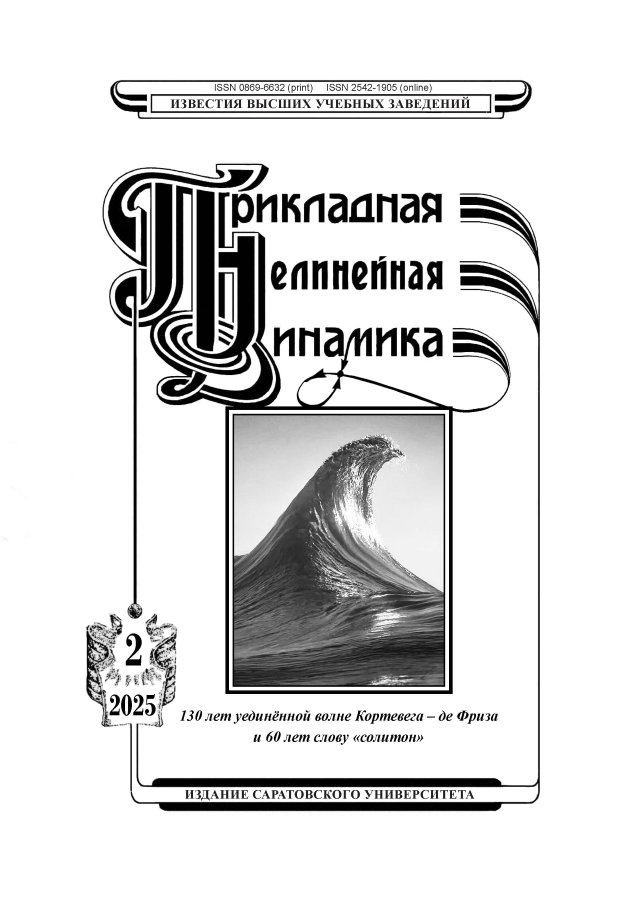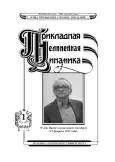Обобщенная система Рабиновича-Фабриканта: уравнения и динамика
- Авторы: Кузнецов С.П.1, Тюрюкина Л.В.2,1
-
Учреждения:
- Саратовский филиал Института радиотехники и электроники имени В.А.Котельникова РАН (СФ ИРЭ)
- Саратовский национальный исследовательский государственный университет имени Н.Г. Чернышевского
- Выпуск: Том 30, № 1 (2022)
- Страницы: 7-29
- Раздел: Статьи
- URL: https://journals.rcsi.science/0869-6632/article/view/251988
- DOI: https://doi.org/10.18500/0869-6632-2022-30-1-7-29
- ID: 251988
Цитировать
Полный текст
Аннотация
Об авторах
Сергей Петрович Кузнецов
Саратовский филиал Института радиотехники и электроники имени В.А.Котельникова РАН (СФ ИРЭ)410019 Саратов, ул. Зеленая, 38 Телефон: (8452) 24-58-23
Людмила Владимировна Тюрюкина
Саратовский национальный исследовательский государственный университет имени Н.Г. Чернышевского; Саратовский филиал Института радиотехники и электроники имени В.А.Котельникова РАН (СФ ИРЭ)410012, Россия, Саратов, ул. Астраханская, 83
Список литературы
- Кузнецов С. П. Динамический хаос. М.: Физматлит, 2006. 356 с.
- Ott E. Chaos in Dynamical Systems. Cambridge: Cambridge University Press, 1993. 385 p.
- Гукенхеймер Дж., Холмс П. Нелинейные колебания, динамические системы и бифуркации векторных полей. М.-Ижевск: Институт компьютерных исследований, 2002. 561 с.
- Анищенко В. С., Вадивасова Т. Е., Астахов В. В. Нелинейная динамика хаотических и стохастических систем. Саратов: Изд-во Сарат. ун-та, 1999. 367 с.
- Шустер Г. Детерминированный хаос. М.: Мир, 1988. 240 с.
- Кузнецов С. П. Динамический хаос и гиперболические аттракторы: от математики к физике. М.-Ижевск: Институт компьютерных исследований, 2013. 488 с.
- Неймарк Ю. И., Ланда П. С. Стохастические и хаотические колебания. М.: Наука, 1987. 424 с.
- Lorenz E. N. The Essence of Chaos. Seattle, WA, USA: University of Washington Press, 1995. 240 p.
- Alligood K. T., Sauer T., Yorke J. Chaos: An Introduction to Dynamical Systems. New York: Springer-Verlag, 1996. 603 p. doi: 10.1007/b97589.
- Hilborn R. C. Chaos and Nonlinear Dynamics: An Introduction for Scientists and Engineers. Oxford: Oxford University Press, 2001. 672 p.
- Рабинович М. И., Фабрикант А. Л. Стохастическая автомодуляция волн в неравновесных средах // Журнал экспериментальной и теоретической физики. 1979. Т. 77, № 2. С. 617-629.
- Danca M.-F., Feckan M., Kuznetsov N., Chen G. Looking more closely to the Rabinovich- Fabrikant system // International Journal of Bifurcation and Chaos. 2016. Vol. 26, no. 2. P. 1650038. doi: 10.1142/S0218127416500383.
- Liu Y., Yang Q., Pang G. A hyperchaotic system from the Rabinovich system // Journal of Computational and Applied Mathematics. 2010. Vol. 234, no. 1. P. 101-113. doi: 10.1016/j.cam.2009.12.008.
- Agrawal S. K., Srivastava M., Das S. Synchronization between fractional-order Rabinovich- Fabrikant and Lotka-Volterra systems // Nonlinear Dynamics. 2012. Vol. 69, no. 4. P. 2277-2288. doi: 10.1007/s11071-012-0426-y.
- Srivastava M., Agrawal S. K., Vishal K., Das S. Chaos control of fractional order Rabinovich- Fabrikant system and synchronization between chaotic and chaos controlled fractional order Rabinovich-Fabrikant system // Applied Mathematical Modelling. 2014. Vol. 38, no. 13. P. 3361-3372. doi: 10.1016/j.apm.2013.11.054.
- Danca M.-F. Hidden transient chaotic attractors of Rabinovich-Fabrikant system // Nonlinear Dynamics. 2016. Vol. 86, no. 2. P. 1263-1270. doi: 10.1007/s11071-016-2962-3.
- Danca M.-F., Kuznetsov N., Chen G. Unusual dynamics and hidden attractors of the Rabinovich- Fabrikant system // Nonlinear Dynamics. 2017. Vol. 88, no. 1. P. 791-805. doi: 10.1007/s11071-016-3276-1.
- Danca M.-F., Chen G. Bifurcation and chaos in a complex model of dissipative medium // International Journal of Bifurcation and Chaos. 2004. Vol. 14, no. 10. P. 3409-3447. doi: 10.1142/S0218127404011430.
- Luo X., Small M., Danca M.-F., Chen G. On a dynamical system with multiple chaotic attractors // International Journal of Bifurcation and Chaos. 2007. Vol. 17, no. 9. P. 3235-3251. doi: 10.1142/S0218127407018993.
- Кузнецов А. П., Кузнецов С. П., Тюрюкина Л. В. Сложная динамика и хаос в модельной системе Рабиновича-Фабриканта // Известия Саратовского университета. Новая серия. Серия Физика. 2019. Т. 19, № 1. С. 4-18. doi: 10.18500/1817-3020-2019-19-1-4-18.
- Hocking L. M., Stewartson K. On the nonlinear response of a marginally unstable plane parallel flow to a two-dimensional disturbance // Proc. R. Soc. Lond. A. 1972. Vol. 326, no. 1566. P. 289-313. doi: 10.1098/rspa.1972.0010.
- Андронов А. А., Фабрикант А. Л. Затухание Ландау, ветровые волны и свисток // Нелинейные волны. М.: Наука, 1979. С. 68-104.
- Kuramoto Y., Yamada T. Turbulent state in chemical reactions // Progress of Theoretical Physics. 1976. Vol. 56, no. 2. P. 679-681. doi: 10.1143/PTP.56.679.
Дополнительные файлы










